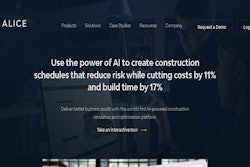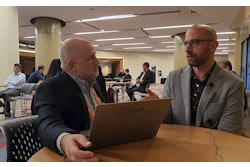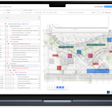
There are 64 squares on a chess board, and 32 pieces. Excluding illegal or obvious bad moves, the number of viable games is about 1040. The human mind cannot conceive of that many possibilities, interdependencies and outcomes, but an app that comes free on your cell phone can.
The number of possible options, schedules, sequences of tasks and approaches a building team may consider to execute a project is similarly complex. That is the problem ALICE Technologies is working on with what it calls the first construction optioneering software product.
While planners and project managers may determine a schedule based on axioms, rules of thumb or habit based on experience, ALICE will run 600 million potential schedules, compare them and identify an optimal approach.
ALICE Technologies completed a $14 million extension of its series B funding round, bring its series B raise to $47 million. At the time of IRONPROS’ April 2023 briefing with CEO René Morkos and CMO Phil Carpenter, the Menlo Park, Cal. company employed about 80, including six dedicated to net new sales and about 25 dedicated to customer success. Customer success is taken seriously, according to Morkos, and customers get a few options in terms of how much help they get.
“Usually, we deal with large clients who expect a full time equivalent or something in that vicinity, but not 100 percent of the time,” Morkos said. “We have customers that want to do it all themselves, who don’t want any help from ALICE—others who want us to do 100 percent of implementation. Regardless, there is always someone who owns the relationship, but the amount of work we take on my vary.”
It is always smart for a contractor to take ownership of their construction software implementation is always smart, ALICE customers will benefit from at least some guidance given the novel nature of this emerging artificial intelligence (AI).
“For us, it is not just about getting value out of simulations and optimizing, but by giving them an understanding of how the system is set up,” Morkos said. “When we work with clients, the ideal scenario is 60 to 70 percent of the work and, they do 40 to 30 percent of the work. That way, they can see how powerful the application is. They can be adding cranes and overtime and rapidly being able to see the impact on the simulation of the construction project. But also, they can be involved in setting up constraints and the rules.”
Scheduling around constraints is something software used in other industries have done for years—but often in areas like inventory or staff resources where there are fewer variables. On a construction project, everything from the soil the project is built on, prevailing weather patterns, permitting, equipment availability and traffic can be constraints.
This being the case, how can AI account for enough of them to drive value through an enterprise planning product?
“We have built a constraint modeling language or software and what you can do is model any type of constraint that you want,” Morkos said. “We have been doing this for several years, so it is rare to encounter constraints we can’t put in the system.”
There are countless types of projects, and to compound the complexity, each one will be unique. This makes flexibility and a robust approach to configurability essential for a product like ALICE to work.
“We want to make sure you can run any option that you want, and that is really kind of important,” Morkos said. “You cannot have an AI solution like this and then have a customer ask if they can model a certain type of project and find we can’t do cranes or crane radii or overtime. Because then, you can’t model the entire project.”
ALICE Tech Stack
Morkos stresses that ALICE is built on explainable AI as opposed to a neural network.
“The upside of neural net is you don’t have to explain the problem,” Morkos said. “It can look at the problem 10,000 times and then solve it. The downside is accuracy. Accuracy is never 100%. For a vision recognition algorithm, 98% or 99% accuracy is considered world class. The other downside is you don’t have an explanation to how it is solved.”
ALICE users upload a 3D model and get back a buildable 4D schedule. Lacking a BIM model, users can also input a block diagram. Once the application generates an optimal schedule, the various inflection points that lead it to arrive at its solution can be exposed. According to Morkos, ALICE ingests the scope of the project, rules about how that scope gets built and multiplies the rules across the scope. Users can import prior projects to drive the analysis, but Morkos says the team is still working on an ability to important existing schedules and integrate with other scheduling software products. ALICE can however ingest .CSV files.
“Because it's a constraint-based system, we can tell you the shortcomings of this approach,” Morkos said. “With a constraint-based solution, we can easily tell you mathematically why this solution is faster. There is an additional layer that our customers sometimes ask for, which is to explain the solution to me, not in mathematical terms, but in English terms, like show me the pattern that causes the east-to-west solution to be faster than the west-to-east solution. And I figured that out. And that's trickier for an algorithm to do.”
Here, Morkos suggests users balance the ease of a narrative description with the cold mathematical descriptors that may still be more illuminating.
ALICE runs on Amazon Web Services and makes heavy use of the Scala programming language and Angular for mobile and web applications. Morkos said the team ships product about once a week and is making ongoing investments in keeping the stack current, moving to the latest version of Scala and Angular framework.
“As we've grown as a company, security and stability have become major things,” Morkos said. “So, we've rewritten the architecture to take into account those things. Like, for example, being able to spin up a server in Australia, because we're working with Australian Government should be a lot easier moving forward.”
ALICE Pricing and Market
ALICE Technologies charges customers based on the size of projects they run over the platform during a one-year subscription. While the subscription includes an unlimited number of users, the number of users is still a small handful of professionals even in a large firm or enterprise.
Carpenter said nonresidential generals, asset owners, infrastructure, industrial or oilfield contractors with $100 million or more in revenue tend to find the technology a fit. The application has not found as strong a market in the trades with one exception.
“We sell both to generals and to owners,” Carpenter said. “There are some exceptions, including concrete. Folks doing concrete often do big chunks of a project.”
“The system was designed from the ground up to do reinforced concrete cast in place projects,” Morkos said. “I really felt early on that we needed to focus on a very specific type of problem solve, and is at the time unsolvable. Trying to solve everything for everybody, I think would kill us. And so, from the ground up, we focused on reinforced concrete cast in place projects. And so now that we've layered onto what it can do with mechanical, electrical, plumbing, facades, steel—they can do all those other kinds of projects.”
General contractors that self-perform and own equipment assets can be excellent fits, according to Carpenter.
“They own the assets and are responsible for making the best use of those assets,” Carpenter said. “If all the gear is yours, and you're trying to optimize its usage, maximize its usage, then you really care about efficiency. We're very good at optimizing for efficiency, so great, you know exactly what equipment you need to bring into the site at a given time to do the work, and then you move it along and take, for example, that crane on to the next site and do the next piece of work. We just signed another contract recently with a general contractor, but they are all self-perform. And that's why it was a nice fit for us.”
BOTTOM LINE: With this product, ALICE Technologies seems to be doing for construction what Autodesk is doing for planning in its announcement this week regarding Autodesk Forma. The ability to reduce a project timeline by 17% or a budget by 13% is a significant competitive advantage. Making an emerging product like ALICE central to the way you do business is something a CFO or other senior executive may look at cautiously. ALICE Technologies has a few advantages though, including commercial acceptance by some large generals and a growing partner program that should lower the cost of a new account and help them grow faster than their own sales headcount. Areas for further research by buyers engaging with ALICE could perhaps be any visibility into integrations that could make ALICE more of an integral part of a construction workflow. This could make it function more like scheduling optimization tools used in settings like field service which can constantly adjust a schedule in real time based on unfolding events.















